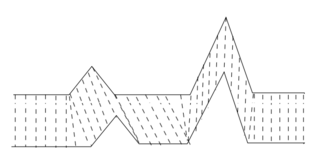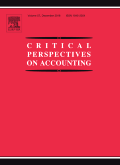
In time series analysis, dynamic time warping (DTW) is an algorithm for measuring similarity between two temporal sequences, which may vary in speed. For instance, similarities in walking could be detected using DTW, even if one person was walking faster than the other, or if there were accelerations and decelerations during the course of an observation. DTW has been applied to temporal sequences of video, audio, and graphics data — indeed, any data that can be turned into a one-dimensional sequence can be analyzed with DTW. A well-known application has been automatic speech recognition, to cope with different speaking speeds. Other applications include speaker recognition and online signature recognition. It can also be used in partial shape matching applications.
The h-index is an author-level metric that measures both the productivity and citation impact of the publications, initially used for an individual scientist or scholar. The h-index correlates with success indicators such as winning the Nobel Prize, being accepted for research fellowships and holding positions at top universities. The index is based on the set of the scientist's most cited papers and the number of citations that they have received in other publications. The index has more recently been applied to the productivity and impact of a scholarly journal as well as a group of scientists, such as a department or university or country. The index was suggested in 2005 by Jorge E. Hirsch, a physicist at UC San Diego, as a tool for determining theoretical physicists' relative quality and is sometimes called the Hirsch index or Hirsch number.

In computational geometry, the relative neighborhood graph (RNG) is an undirected graph defined on a set of points in the Euclidean plane by connecting two points and by an edge whenever there does not exist a third point that is closer to both and than they are to each other. This graph was proposed by Godfried Toussaint in 1980 as a way of defining a structure from a set of points that would match human perceptions of the shape of the set.
Sammon mapping or Sammon projection is an algorithm that maps a high-dimensional space to a space of lower dimensionality by trying to preserve the structure of inter-point distances in high-dimensional space in the lower-dimension projection.
A chain code is a lossless compression based image segmentation method for binary images based upon tracing image contours. The basic principle of chain coding, like other contour codings, is to separately encode each connected component, or "blob", in the image.
The Journal of the Academy of Nutrition and Dietetics is the monthly peer-reviewed scientific journal of the Academy of Nutrition and Dietetics published by Elsevier. It covers research in nutritional science, medical nutrition therapy, public health nutrition, food science and biotechnology, foodservice systems, leadership and management, and dietetics education.

Signature recognition is an example of behavioral biometrics that identifies a person based on their handwriting. It can be operated in two different ways:

Handwritten biometric recognition is the process of identifying the author of a given text from the handwriting style. Handwritten biometric recognition belongs to behavioural biometric systems because it is based on something that the user has learned to do.

Eleanor Anne Maguire is an Irish neuroscientist. Since 2007, she has been Professor of Cognitive Neuroscience at University College London where she is also a Wellcome Trust Principal Research Fellow.
Matti Kalevi Pietikäinen is a computer scientist. He is currently Professor (emer.) in the Center for Machine Vision and Signal Analysis, University of Oulu, Finland. His research interests are in texture-based computer vision, face analysis, affective computing, biometrics, and vision-based perceptual interfaces. He was Director of the Center for Machine Vision Research, and Scientific Director of Infotech Oulu.
Sayre's paradox is a dilemma encountered in the design of automated handwriting recognition systems. A standard statement of the paradox is that a cursively written word cannot be recognized without being segmented and cannot be segmented without being recognized. The paradox was first articulated in a 1973 publication by Kenneth M. Sayre, after whom it was named.
Josef KittlerFREng is a British scientist and Distinguished Professor at University of Surrey, specialising in pattern recognition and machine intelligence.

Critical Perspectives on Accounting is a peer-reviewed academic journal published by Elsevier. The aim of the journal is to study how accounting works within society and to promote forms of accounting that are in the public interest. It was established in 1990 with David J. Cooper, and A.M. Tinker as founding editors-in-chief. They were succeeded in 2008 by Marcia Annisette, Christine Cooper, and Dean Neu. The current editors-in-chief are Jane Andrew, Christine Cooper, and Yves Gendron.
Raymond Ethan Goldstein FRS FInstP is the Alan Turing Professor of Complex Physical Systems in the Department of Applied Mathematics and Theoretical Physics (DAMTP) at the University of Cambridge and a Fellow of Churchill College, Cambridge.
Hemoglobin J is an abnormal hemoglobin, an alpha globin gene variant and present in various geographic locations. It was first reported in a black American family in 1956, and later reported from Indonesia, India, and other parts of the world. Hemoglobin J reported from Meerut India shows the mutation of 120th alanine to glutamic acid on alpha chain. Hemoglobin J was also reported from Chhattisgarh, Central India as revealed by Lingojwar and coworkers in 2016.
Ulisses M. Braga Neto is a Brazilian-American electrical engineer and is currently Professor of Electrical and Computer Engineering at Texas A&M University. His main research areas are statistical pattern recognition, machine learning, signal and image processing, and systems biology. He has worked extensively in the field of error estimation for pattern recognition and machine learning, having published with Edward R. Dougherty the first book dedicated to this topic. Braga-Neto has also published a classroom textbook on Pattern Recognition and Machine Learning. He has also made contributions to the field of Mathematical morphology in signal and image processing.
Indic OCR refers to the process of converting text images written in Indic scripts into e-text using Optical character recognition (OCR) techniques. Broadly, it can also refer to the OCR systems of Brahmic scripts for languages of South Asia and Southeast Asia, not just the scripts of the Indian subcontinent, which are all written in an abugida-based writing system.
Discrete Skeleton Evolution (DSE) describes an iterative approach to reducing a morphological or topological skeleton. It is a form of pruning in that it removes noisy or redundant branches (spurs) generated by the skeletonization process, while preserving information-rich "trunk" segments. The value assigned to individual branches varies from algorithm to algorithm, with the general goal being to convey the features of interest of the original contour with a few carefully chosen lines. Usually, clarity for human vision is valued as well. DSE algorithms are distinguished by complex, recursive decision-making processes with high computational requirements. Pruning methods such as by structuring element (SE) convolution and the Hough transform are general purpose algorithms which quickly pass through an image and eliminate all branches shorter than a given threshold. DSE methods are most applicable when detail retention and contour reconstruction are valued.

Graeme C. Hays is a British and Australian marine ecologist known for his work with sea turtles and plankton. He is the Alfred Deakin Professor of Marine Science at Deakin University, Australia.
Wang Gang, also known as Michael Wang, is an electrical and computer engineer and academic specializing in Artificial Intelligence and its application in autonomous driving. Wang has authored or co-authored more than 100 publications, cited over 28,000 times. His h-index is computed to be 72.






